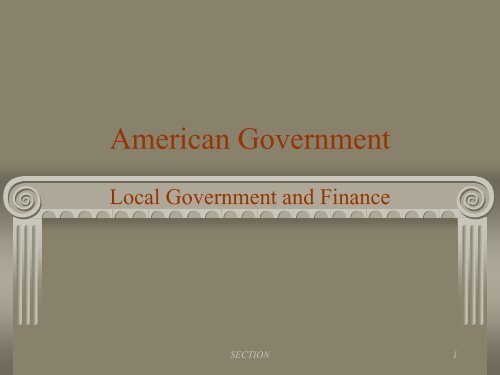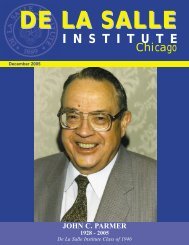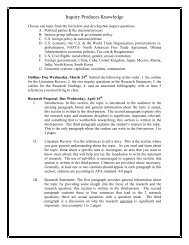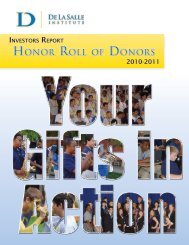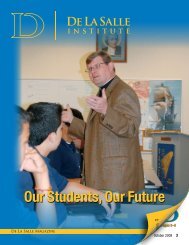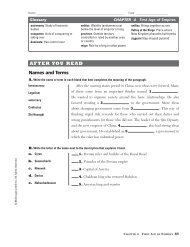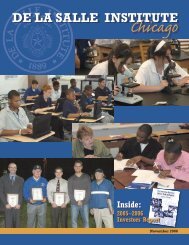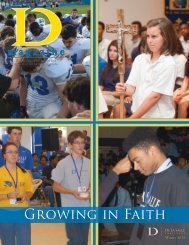Local Gov_t and Finance
Local Gov_t and Finance
Local Gov_t and Finance
- No tags were found...
Create successful ePaper yourself
Turn your PDF publications into a flip-book with our unique Google optimized e-Paper software.
American <strong>Gov</strong>ernment<strong>Local</strong> <strong>Gov</strong>ernment <strong>and</strong> <strong>Finance</strong>SECTION 1
Counties, Towns, <strong>and</strong> TownshipsWhat are some differences amongcounties?How are county governments structured?What are the functions of counties?Which aspects of county government needreform?How can we describe the governments oftowns, townships, <strong>and</strong> special districts?SECTION 2
Counties• A county is a major unit of local government inmost States.• The function of counties varies from State to State.• They may share the functions of local governmentor be the major units of government for rural areas.• Counties vary widely in area <strong>and</strong> population.SECTION 3
County <strong>Gov</strong>ernment StructureSECTION 4
The Functions of CountiesThe most common functions of counties are:to keep the peace <strong>and</strong> maintain jails <strong>and</strong> othercorrectional facilitiesto asses property for taxesto collect taxes <strong>and</strong> spend county fundsto build <strong>and</strong> repair roads, bridges, drains, <strong>and</strong>other such public worksto maintain schoolsSECTION 5
The Need for ReformToo many elected officials so that it is difficult forcitizens to form an informed vote <strong>and</strong> to find theofficials responsible for a given concern.Too many counties in some States make Stategovernment difficult to manage.SECTION 6
Towns, Townships, <strong>and</strong> Special DistrictsIn New Engl<strong>and</strong> <strong>and</strong> elsewhere, the town or township is amajor unit of local government <strong>and</strong> delivers most services.The main feature is the town or township meeting, whichis open to all of the town’s eligible voters. It meetsregularly to levy taxes, make spending <strong>and</strong> other policydecisions, <strong>and</strong> elect officers.Between town meetings, a small governing body managesthe town’s business.SECTION 7
Towns, Townships, <strong>and</strong> Special DistrictsSpecial Districts also exist across the country.Most of them are school districts.Special districts provide a service in a wider orsmaller area than is covered by a county orcity.SECTION 8
Cities <strong>and</strong> Metropolitan AreasWhat are the reasons for America’s shift from arural to an urban society?How are cities incorporated, <strong>and</strong> what is thefunction of city charters?What are the major forms of city government?Why is city planning necessary?What challenges face the suburbs <strong>and</strong>metropolitan areas?SECTION 9
America’s Rural-Urban ShiftIn 1790, 5.1 percent of the population lived in cities.The Industrial Revolution caused many people to moveto urban centers.Farms became mechanized <strong>and</strong> fewer people grew morefood.By 1900, two-fifths of the nation’s people lived in urbanareasSECTION 10
America’s Rural-Urban ShiftBy 1920, more than half of the population werecity dwellers.Today, over 75 percent live in cities <strong>and</strong> suburbs.Consequently, the strain on local governments toprovide services to their populations has grown.SECTION 11
Incorporation <strong>and</strong> ChartersIncorporation is the process by which aState establishes a city as a legal body.A charter is the city’s basic law,its constitution.SECTION 12
Mayor-Council Form of City <strong>Gov</strong>ernmentSECTION 13
Commission Form of City <strong>Gov</strong>ernmentSECTION 14
Council-Manager Form of City <strong>Gov</strong>ernmentSECTION 15
City PlanningPlanning GrowthMost cities have aplanning agency thatconsists of a planningcommission supportedby a professionalstaff.Most federal grant <strong>and</strong>loan programs requirea master plan forfuture growth.City ZoningZoning is the practice of dividing a cityinto districts <strong>and</strong> regulating propertyuses.The three uses are generally residential,commercial, <strong>and</strong> industrial.Each zone is then subdivided.Residential zones may be subdivided intosingle-family, two family, <strong>and</strong>multifamily units.Zoning may also determine height <strong>and</strong>area limits for buildings.Zoning ordinances must be reasonable.SECTION 16
Municipal FunctionsPublic utilitiesParks <strong>and</strong>recreationSanitationPublic housing Building codes Police <strong>and</strong> fireprotectionAuditoriums <strong>and</strong> sportsarenasInfrastructure building <strong>and</strong>maintenanceSchool <strong>and</strong> correctionalinstitutionsPublic health facilitiesSECTION 17
Suburbs <strong>and</strong> Metropolitan AreasThe Suburb BoomAbout half of all Americans livein suburbs.Suburbs grew rapidly afterWorld War II.Americans wanted more room,cheaper l<strong>and</strong>, privacy, <strong>and</strong> lesspollution <strong>and</strong> congestion.Businesses moved to thesuburbs for cheaper l<strong>and</strong>, lowertaxes, <strong>and</strong> a stable labor supply.The move to the suburbs mademany urban areas lessfinancially stable <strong>and</strong> sociallyinclusive.Metropolitan AreasSome suburbs have difficultymeeting the service needs oftheir residents.Metropolitan areas have beencreated that annex outlyingareas.Special districts are created thatcross the boundaries of county<strong>and</strong> city lines.SECTION 18
Providing Important FunctionsWhy do State governments have a major role in providingimportant services?What types of services do State <strong>and</strong> local governmentsprovide?Why do the amount <strong>and</strong> types of services available tocitizens vary greatly from State to State?SECTION 19
State <strong>Gov</strong>ernment’s RoleThe U.S. Constitution reserves to the States all thepowers not expressly delegated to Congress <strong>and</strong>not specifically denied to the States.State responsibilities are to “establish Justice,ensure domestic Tranquility, provide for thecommon defense, promote the general Welfare,<strong>and</strong> secure the Blessings of Liberty.”SECTION 20
State <strong>and</strong> <strong>Local</strong> ServicesSECTION 21
Variations in ServicesState <strong>and</strong> localgovernments varyin the amount <strong>and</strong>types of servicesthey offeraccording to thedegree ofurbanization.They also varyaccording tophysical geography(energy supplies,agriculturalresources, <strong>and</strong>proximity totransportationnetworks <strong>and</strong> majormarkets).SECTION 22
Financing State <strong>and</strong> <strong>Local</strong> <strong>Gov</strong>ernmentWhat are the major Federal <strong>and</strong> State limits onraising revenue?What are the four principles of sound taxation?What are the major tax <strong>and</strong> nontax sources ofState <strong>and</strong> local revenue?How can we describe the State budget process?SECTION 23
Limits on Raising RevenueFederal LimitationsStates cannot raise revenuefrom:interstate <strong>and</strong> foreigncommercethe Federal <strong>Gov</strong>ernment <strong>and</strong>its agenciesany unfairly imposed oradministered taxtaxes that require confiscatedpropertytaxes imposed for other thanpublic purposesState LimitationsState constitutions limit theState <strong>and</strong> local taxingpowers.Most constitutions createtax-exempt groups.State codes often setmaximum rates for levies.Some taxes are prohibited.SECTION 24
The Principles of Sound TaxationSubjects contribute in proportion to theirabilities.Taxes are certain <strong>and</strong> not arbitrary.Taxes are levied at a time <strong>and</strong> in a mannerconvenient to the contributor.Taxes should not take much more money fromthe people than government needs.SECTION 25
Sources of RevenueSECTION 26
The Budget ProcessEach agency prepares estimates of itsneeds for the upcoming year.Estimates are reviewed by an executivebudget agency.The revised estimates <strong>and</strong> supportinginformation are presented as thegovernor’s budget.SECTION 27
The Budget ProcessThe budget is considered part by part, fundsare appropriated, <strong>and</strong> revenue measurespassed by the legislature.The governor supervises the execution ofthe budget approved by the legislature.The execution of the budget is checkedindependently by auditors.SECTION 28


